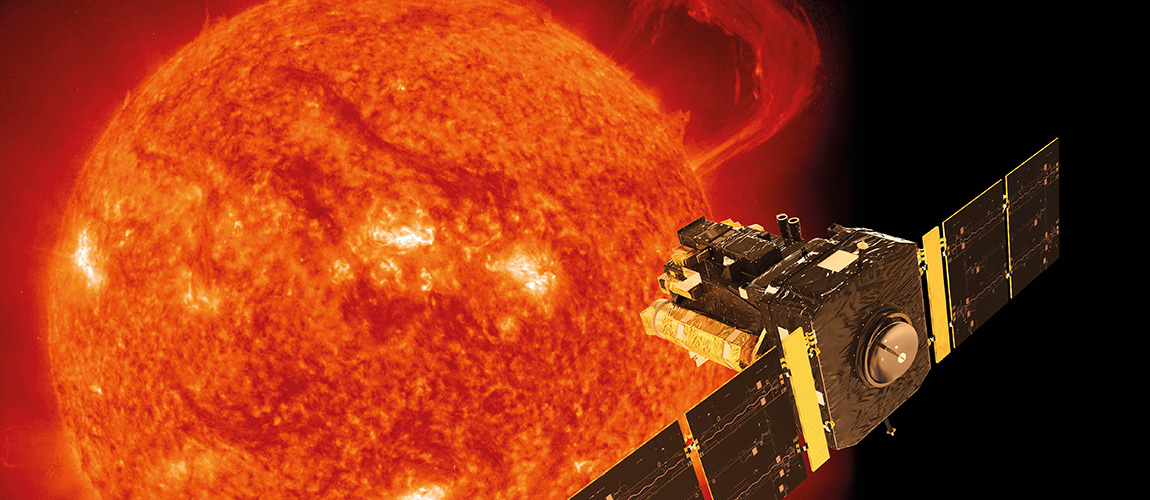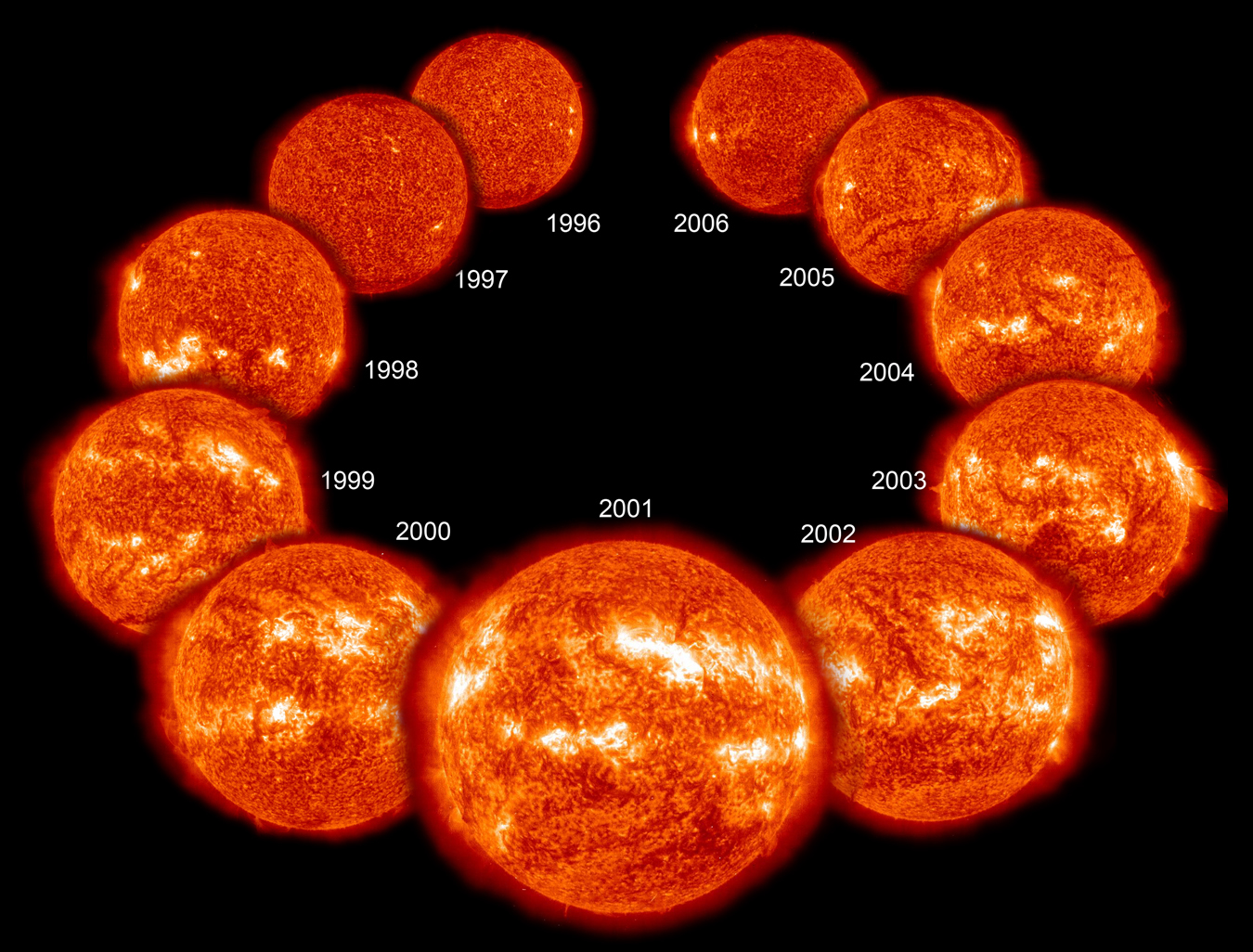The age of the Sun depends on when you look at it
Previously thought to be negligible, the Sun’s magnetic activity is influencing the determination of its seismic age, as shown by a study published by an international team led by a researcher from the UNIGE.
 Illustration of the SOHO satellite orbiting the Sun. Among the measurement tools on board is the GOLF instrument, which provided some of the data used in the study. © SOHO/ESA/NASA
Illustration of the SOHO satellite orbiting the Sun. Among the measurement tools on board is the GOLF instrument, which provided some of the data used in the study. © SOHO/ESA/NASA
An international team of astronomers, led by a researcher from the University of Geneva (UNIGE), has shown that the Sun’s magnetic activity has a significant influence on its seismic characterisation, contrary to predictions in the literature. Important data such as its size, age and chemical composition depend on it. These results pave the way for in-depth research to better understand the nature of the magnetic activity and its impact on stellar oscillations. The study can be found in the journal Astronomy & Astrophysics.
Asteroseismology, or helioseismology in the case of the Sun, is a fascinating branch of astronomy that studies the oscillations of stars. ‘To understand it, you must imagine a star as a big ball of gas in constant motion. Inside this star, there are waves or pulsations that make it vibrate, rather like the sound that resonates in a musical instrument’, explains Jérôme Bétrisey, a postdoctoral researcher in the Astronomy Department of the Faculty of Science at the UNIGE and first author of the study. ‘These vibrations cause the star’s surface to move slightly and change luminosity regularly. Thanks to very precise instruments, we can detect these variations in luminosity from Earth or from space’, continues the researcher.
Listen to the symphony of the stars
By observing these changes, researchers can learn a great deal about the star’s internal structure and determine important characteristics such as its size, age, chemical composition or stage in the stellar life cycle. A precise understanding of the characteristics of stars is essential, among other things, to determine the properties of the planets that surround them or to retrace the history of the Milky Way.
Despite some major successes in recent decades, asteroseismology has also shown that there are significant differences between observations and the predictions of theoretical models of the inner workings of stars. Over the years, various methods have been developed to reduce these discrepancies, with varying degrees of success. However, none of the current methods consider the magnetic activity of stars, its impact on the results being supposed to be negligible.
The international team led by Jérôme Bétrisey has just demonstrated the opposite. It has established that the age of the Sun, as determined by helioseismology, varies significantly according to the level of activity of the solar cycle. To give an order of magnitude, the Sun is around 4.6 billion years old, and variations of up to 300 million years have been observed between solar minima. Although these variations may seem small compared with the age of the Sun, they are no longer negligible given the level of precision that will be achieved by future space missions.
The seismic age of the Sun correlates with the solar activity cycle
To better understand the impact of magnetic activity on the Sun, the scientists analysed 26.5 years of solar data, covering two complete activity cycles. They divided this data into around 90 small one-year series, each three months apart. For each of these series, a seismic analysis was carried out, making it possible to measure the evolution of the Sun’s fundamental properties such as its mass, radius and age over time.
 Evolution of the Sun during cycle 23. The image shows a collage of 11 photographs of the Sun taken by the SOHO satellite and highlights the 11-year solar activity cycle with minima around 1996 and 2006 and a maximum around 2001. © SOHO/ESA/NASA
Evolution of the Sun during cycle 23. The image shows a collage of 11 photographs of the Sun taken by the SOHO satellite and highlights the 11-year solar activity cycle with minima around 1996 and 2006 and a maximum around 2001. © SOHO/ESA/NASA
Two independent data sets were used to check the robustness of the results. One came from the University of Birmingham’s BiSON (Birmingham Solar Oscillations Network) network of ground-based telescopes, and the other from the GOLF (Global Oscillations at Low Frequencies) instrument on board the SOHO (Solar and Heliospheric Observatory) satellite, which has been orbiting the Sun since the mid-1990s.
Regardless of the configuration tested, the age of the Sun determined by helioseismology was correlated with the level of activity of the solar cycle. They measured variations of around 6% on average between the periods of solar minimum and maximum, which is very significant in terms of the precision targeted for future space missions that will analyse other similar stars. For example, the PLATO (PLAnetary Transits and Oscillations of stars) mission is aiming for a precision of 10% for the age of a star like the Sun.
The study of the GOLF and BiSON data also showed that the impact of the activity cycle on the seismic age is more marked for the more active of the two cycles studied. This result is logical and expected from a physical point of view. ‘However, the Sun is not a particularly active star, which suggests that the impact of magnetic activity could be very significant for more active stars such as those that PLATO will detect’, adds Jérôme Bétrisey.
A bright future for the study of the magnetic activity of stars
The results of this study show that the magnetic activity of stars poses a major challenge for future space missions such as PLATO, particularly in terms of characterising the most active stars. ‘However, this discovery also opens many exciting research prospects’, concludes Jérôme Bétrisey.
The magnetic activity of stars has a significant influence on stellar oscillations, which complicates the precise determination of fundamental properties such as the mass, radius and age of stars. For future space missions, this means that it will be necessary to develop more sophisticated methods to take account of this magnetic impact.
The challenges posed by magnetic activity will also encourage researchers to explore this phenomenon further. This could lead to a better understanding of stellar physics, particularly in terms of how magnetic fields interact with the internal oscillations of stars. This research could also improve our understanding of stellar activity cycles, which are like solar cycles.
19 Aug 2024
